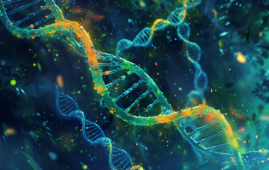

Researchers at Georgetown University’s Lombardi Comprehensive Cancer Center and colleagues who have been studying the complexities of biochemical pathways involved in cancer development have discovered that a type of sugar called glucose is intricately linked to a pathway that is used to build DNA molecules. When this pathway becomes hyperactive, it can lead to cancer and chemoradiotherapy resistance.
The findings appear June 12, 2023, in Nature Chemical Biology.
“For a good while, my lab has been exploring cell signaling and DNA transcription mechanisms by which cellular metabolism changes in response to environmental and genetic cues, with the goal of designing strategies to treat cancer and other diseases,” says Huadong Pei, Ph.D., associate professor in the Department of Oncology at Georgetown Lombardi and a corresponding author of the publication.
“Knowing that cancer cells usually grow quickly and require more glucose than normal cells to reprogram their metabolism has been key to jumpstarting this latest research effort in the hope that we can gain a better understanding of how we can fight cancer at the cellular, or even subcellular level.”
Pei’s current research began when he and his colleagues investigated how nutrients that cells consume in order to survive end up activating protein alterations as a result of adding a sugar termed O-linked -N-acetylglucosamine (O-GlcNAc) to the protein. This reversible and dynamic alteration is emerging as a major regulator of a variety of cellular activities.
The researchers discovered that a key enzyme involved in nucleotide synthesis, called phosphoribosyl pyrophosphate synthetase 1 (PRPS1), is changed by O-G1cNAc in a series of tests in both the lab and on mice. The researchers feel that targeting either the sugar or the enzyme could be crucial in influencing cancer outcomes.
“Ultimately, we would like to be able to design drugs that target DNA nucleotide synthesis, which includes the modifications we’ve identified of adding a sugar to a protein and the catalyzing step acted on by the PRPS1 enzyme,” said Pei. “In particular, we’d like to develop drugs that can be used to make lung cancer more sensitive, or responsive, to radiotherapy and chemotherapy, as resistance to these therapies is still far too common. But there is still a long way to go, and many more experiments will be needed before we can even consider drug design.”
Meanwhile, the researchers plan to test their findings in animal models using mice grafted with human lung cancer tissue to see if medications targeting nucleotide synthesis make lung cancer more susceptible to radiotherapy and chemotherapy.
more recommended stories
 Spatial Computing Explains How Brain Organizes Cognition
Spatial Computing Explains How Brain Organizes CognitionKey Takeaways (Quick Summary) MIT researchers.
 Gestational Diabetes Risk Identified by Blood Metabolites
Gestational Diabetes Risk Identified by Blood MetabolitesKey Takeaways (Quick Summary for Clinicians).
 Phage Therapy Study Reveals RNA-Based Infection Control
Phage Therapy Study Reveals RNA-Based Infection ControlKey Takeaways (Quick Summary) Researchers uncovered.
 Pelvic Floor Disorders: Treatable Yet Often Ignored
Pelvic Floor Disorders: Treatable Yet Often IgnoredKey Takeaways (Quick Summary) Pelvic floor.
 Urine-Based microRNA Aging Clock Predicts Biological Age
Urine-Based microRNA Aging Clock Predicts Biological AgeKey Takeaways (Quick Summary) Researchers developed.
 Circadian Control of Neutrophils in Myocardial Infarction
Circadian Control of Neutrophils in Myocardial InfarctionKey Takeaways for HCPs Neutrophil activity.
 E-Cigarette Use and Heart Attack Risk in Former Smokers
E-Cigarette Use and Heart Attack Risk in Former SmokersKey Takeaways for Clinicians and Nurses.
 36-Week Pre-eclampsia Screening May Reduce Term Risk
36-Week Pre-eclampsia Screening May Reduce Term RiskA New Preventive Strategy for Term.
 Cardiovascular Risk and Sudden Cardiac Death in Diabetes
Cardiovascular Risk and Sudden Cardiac Death in DiabetesRising Sudden Cardiac Death (SCD) Risk.
 Poor Kidney Function and Alzheimer’s Biomarkers Explained
Poor Kidney Function and Alzheimer’s Biomarkers ExplainedPoor kidney function may influence levels.

Leave a Comment